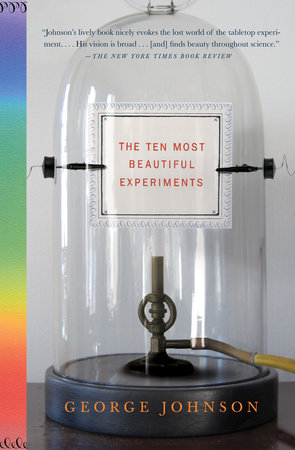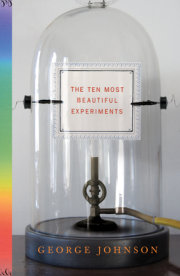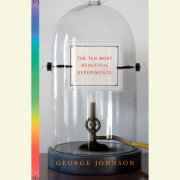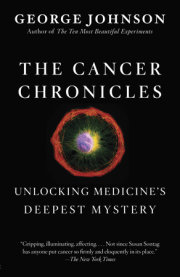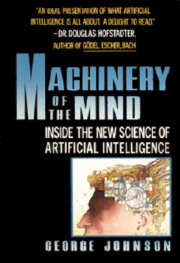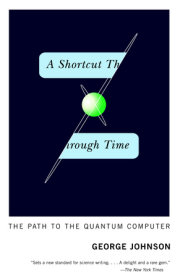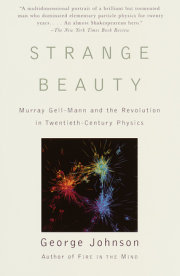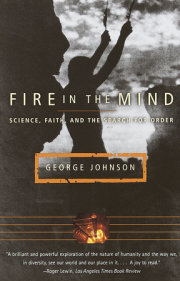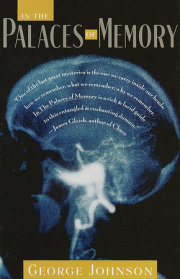chapter 1
Galileo The Way Things Really Move
Galileo Galilei, by Ottavio Leoni
It is very unpleasant and annoying to see men, who claim to be peers of anyone in a certain field of study, take for granted certain conclusions which later are quickly and easily shown by another to be false.
—Salviati, in Galileo,
Two New Sciences When you throw a rock, catch a ball, or jump just hard enough to clear a hurdle, the older, unconscious part of the brain, the cerebellum, reveals an effortless grasp of the fundamental laws of motion. Force equals mass times acceleration. Every action results in an equal and opposite reaction. But this ingrained physics is sealed off from the newer, upper brain-the cerebrum, seat of intelligence and self-awareness. One can leap as gracefully as a cat but be just as powerless to explain the inverse square law of gravity.
Aristotle, in the fourth century BC, made the first ambitious attempt to articulate the rules of motion. An object falls in proportion to its weight-the heavier a rock, the sooner it will reach the ground. For other kinds of movement (pushing a book across a table or a plow across a field), a force must be constantly applied. The harder you push, the faster the object will go. Stop pushing and it will come to a halt.
It all sounds eminently sensible and obvious and, of course, is exactly wrong.
What if you place the book on a sheet of ice and give it a gentle shove? It will keep moving long after the impetus is removed. (Asked why an arrow keeps going after it leaves the bowstring, the Aristotelians said that it was pushed along by the incoming rush of air.) Now we know that something set in motion stays in motion until stopped by something else, or worn down by friction. And a one-pound weight and a five-pound weight, dropped at the same moment, will fall side by side to the ground. Galileo showed it was so.
It's entirely predictable that the great debunker of Aristotle-celebrated in a play by Bertolt Brecht, an opera by Philip Glass, and a pop song by the Indigo Girls-would come in for his own debunking. It is doubtful, historians tell us, that Galileo dropped two weights from the Leaning Tower of Pisa. Nor do they believe that he hit on his insight about pendulums-that each swing is of equal duration-while watching a certain chandelier in the cathedral of Pisa and timing it with his heartbeat.
His credentials as a cosmologist have also dimmed under scrutiny. Galileo was the most eloquent advocate of Copernicus's sun-centered solar system-his
Dialogue Concerning the Two Chief World Systems is the first great piece of popular science writing-but he never accepted Kepler's crucial insight: that the planets move in ellipses. The orbits, Galileo assumed, had to be perfect circles. Here he was following Aristotle, who proclaimed that while motion on Earth (in the “sublunar” realm) must have a beginning and an end, celestial motion is necessarily circular.
For that to be true and match what was happening in the sky, the planets would have to move not just in circles but in circles within circles-the same old epicycles that had weighed down Ptolemy's geocentric universe. Galileo brushed off the problem. Most disappointing of all, he probably did not, as legend has it, follow his forced apology to the Inquisitors of Rome by muttering under his breath,
Eppur si muove, “And yet it moves.” He was no martyr. Knowing he had been beaten, he retired to the solitude of Arcetri to lick his wounds.
Galileo's strongest claim to greatness lies in work he did long before his troubles with the Vatican. He was studying nothing so grand as stars or planets but the movement of simple, mundane objects-a subject far more perplexing than anyone had imagined.
Whether or not the research actually began at the Tower of Pisa hardly matters. He described a similar experiment in his other masterpiece,
Discourses Concerning Two New Sciences, completed during his final years of exile. Like the earlier work it is cast as a long conversation among three Italian noblemen-Salviati, Sagredo, and Simplicio-who are try¬ing to understand how the world works.
Salviati is the stand-in for Galileo, and on the first day of the gathering he insists that, dropped simultaneously, a cannonball weighing 100 pounds and a musket ball weighing 1 pound will hit the ground at almost the same time. In an experiment, he concedes, the heavier one did in fact land “two finger-breadths” sooner, but Salviati recognized that other factors, like air resistance, muddied the results. The important point was that the impacts were
almost in unison: when the cannonball hit the ground, the musket ball had not traveled just the distance-a single cubit-as common sense would have predicted. “Now you would not hide behind these two fingers the ninety-nine cubits of Aristotle,” he chided,“nor would you mention my small error and at the same time pass over in silence his very large one.” All other things being equal, the speed at which an object falls is independent of its weight.
A harder question was what happened between the time a ball was released and the time it struck the ground. It would pick up speed along the way-everybody knew that. But how? Was there a large spurt of motion at the beginning, or a lot of little spurts continuing all the way down?
With nothing like time-lapse photography or electronic sensors to clock a falling body, all you could do was speculate. What Galileo needed was an equivalent experiment, one in which the fall would be slower and easier to observe: a ball rolling down a smooth, gentle plane. What was true for its motion should be true for a steeper incline-and for the steep¬est: straight down. He had found a way to ask the question.
The year was probably 1604. Three decades later he, or rather Salviati, described the thrust of the experiment:
A piece of wooden moulding or scantling, about 12 cubits long, half a cubit wide, and three finger-breadths thick, was taken. On its edge was cut a channel a little more than one finger in breadth. Having made this groove very straight, smooth, and polished, and having lined it with parchment, also as smooth and polished as possible, we rolled along it a hard, smooth, and very round bronze ball.
A scantling is a piece of wood, and a Florentine cubit was twenty inches, so we can imagine Galileo with a twenty-foot long board, ten inches wide, propping it up at an angle.
Having placed this board in a sloping position, by lifting one end some one or two cubits above the other, we rolled the ball, as I was just saying, along the channel, noting, in a manner presently to be described, the time required to make the descent. We repeated this experiment more than once in order to measure the time with an accuracy such that the deviation between two observations never exceeded one-tenth of a pulse-beat.
Once they had perfected the technique, Salviati went on to explain, they timed how long it took the ball to traverse one-fourth of the track, then two-thirds, then three-fourths. They repeated the experiment with the board set at different slopes-100 measurements in all. These were taken with a simple device called a water clock, essentially an hourglass that parcels out seconds with liquid instead of sand:
We employed a large vessel of water placed in an elevated position. To the bottom of this vessel was soldered a pipe of small diameter giving a thin jet of water, which we collected in a small glass during the time of each descent, whether for the whole length of the channel or for a part of its length. The water thus collected was weighed, after each descent, on a very accurate balance. The differences and ratios of these weights gave us the differences and ratios of the times, and this with such accuracy that although the operation was repeated many, many times, there was no appreciable discrepancy in the results.
The weight of the water was equivalent to the passage of time. Ingenious. But maybe, some modern historians have concluded, a little too good to be true. Reading Galileo's words some three centuries later, Alexandre Koyré, a profes¬sor at the Sorbonne, could barely contain his scorn:
A bronze ball rolling in a “smooth and polished” wooden groove! A vessel of water with a small hole through which it runs out and which one collects in a small glass in order to weigh it afterwards and thus measure the times of descent...What an accumulation of sources of error and inexactitude! It is obvious that the Galilean experiments are completely worthless.
Koyré suspected that there had been no experiment-that Galileo was using an imaginary demonstration with rolling balls as a pedagogical device, an illustration of a law of physics that he had figured out mathematically, through pure deduction, the old-fashioned way. Galileo, it seemed, had been debunked again.
Koyré was writing in 1953. Twenty years later Stillman Drake, one of the leading experts on Galilean science, was sleuthing among the manuscripts in the Biblioteca Nazionale Centrale in Florence when he came across some unpublished pages-entries from Galileo's own notebook.
Galileo was something of a pack rat, and when his notebooks were published around the turn of the twentieth century, the editor, Antonio Favaro, had left out some pages that appeared to be no more than scribbles, a mess of calculations and diagrams that didn't make sense. The pages were apparently out of order, with little clue as to when they had been written or what their author was working on.
Drake was researching a new English translation of
Two New Sciences. For three months at the beginning of 1972,he sat in Florence going through 160 pages of the seventy-second volume of Galileo's papers, comparing watermarks and styles of handwriting, restoring the pages to what seemed a sensible order. Among the earliest were what appeared to be data from the experiment of 1604,when Galileo was in Padua.
From the jottings, Drake re-created the centuries-old experiment, and with just a little license, we can imagine what was going through Galileo's mind. He releases the ball at the top of the wooden incline noting that in the first few moments, it travels a distance of 33
punti, or points. (Galileo was using a ruler marked into sixty equal units, and a point, Drake deduced, was just shy of one millimeter.) After an equal amount of time has passed, the ball, picking up speed, covers a total of 130
punti, and by the end of the third interval, 298
punti. Then 526, 824, 1,192, 1,620 . . . faster and faster. These were real data. For the final distance, when the ball would have been moving at top speed, Galileo had originally written 2,123
punti, scratching it out and correcting it to 2,104. By some of his figures, he put a plus or a minus sign, apparently indicating when his measurements seemed high or low.
The units of time he was using don't matter. We might as well call them ticks. The important thing is that each interval be the same:
123456 7 8 ticks
(time) 33 130 298 526 824 1,192
1,620 2,104
punti (accumulated distance) At first no pattern leaps forth. With each tick the ball covers more ground, but by what rule? Galileo started playing with the numbers. Maybe the speed increased according to some arithmetical progression. What about alternating odd numbers: 1, 5, 9, 13, 17, 21 ...? On the second tick the ball would move five times faster than on the first tick, covering 5 _ 33 or 165
punti. Too high but maybe within the range of experimental error. The distance covered on tick three would be nine times greater: 33 _ 9 = 297
punti. Right on the mark! And on the fourth tick 13 _ 33 = 429.Too low. Then 17 _ 33 = 561, too high. And 21 _ 33 = 693, way too low.... Drake could see on the manuscript page where Galileo scratched out the numbers to try again.
On the first tick the ball had covered 33
punti, then 130. What if you divide the numbers? 130/33 = 3.9. The distance had increased almost four times. With the third tick, the increase was 298/33, slightly more than nine times the initial distance. Then 15.9, 25.0, 36.1, 49.1, 63.8. He rounded the numbers and wrote them, using a different ink and pen, in a column: 4, 9, 16, 25, 36, 49, 64.
He had found the key: allowing for a bit of error, the distance covered increased with the
square of the time. With a longer board, one could confidently predict that on the next tick the factor would be 81 (92) and then 100, 121, 144, 169.... That Galileo's numbers were not exact testified to the reality of the experiment. That they were as close as they were testified to his skill as an experimenter.
In these calculations the distances are cumulative: by the fourth tick the ball has traversed a total of sixteen times the distance it covered at the end of the first tick. But how far does it travel during each separate interval, between ticks three and four compared with ticks two and three? The answer can be backed out with arithmetic.
It is the nature of squares that they are the sums of the odd numbers that precede them: 4 = 1 + 3; 9 = 1 + 3 + 5; 16 = 1 + 3 + 5 + 7. Implicit in the times-square law is that the distances between ticks must increase according to the progression of odd numbers. Galileo's data show how this works.
Tick by tick the ball travels three times the distance, then five times, then seven, then nine. In fact Galileo could have started with the odd-number progression and derived the times-squared relationship. However he did it, the result was a fundamental new law. The steeper the slope, the faster the ball would roll, but always according to the same rule- which would presumably hold if the slope was ninety degrees, straight down.
At the other extreme, a slope of zero degrees, there would be no acceleration. Once the ball, traveling down the incline, reached the flat tabletop, it would begin moving at a uniform speed-forever if the plane was infinite and friction didn't interfere. And if the moving ball reached the edge of the table and dropped off? On the triumphant fourth day of
Two New Sciences, Galileo provides the answer: the unhurried horizontal motion and the downwardly accelerated vertical motion combine to yield the familiar parabolic shape of a projectile.
Copyright © 2009 by George Johnson. All rights reserved. No part of this excerpt may be reproduced or reprinted without permission in writing from the publisher.

